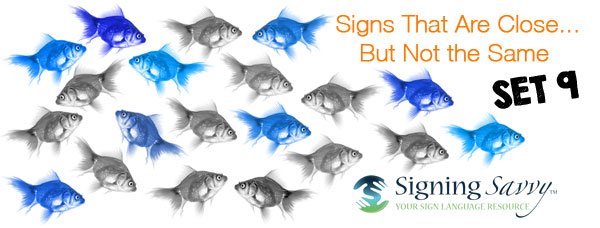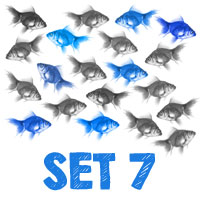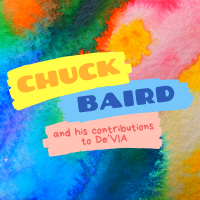
Signs That Are Close... But Not the Same - Set 9
This article is part of our “Signs That Are Close... But Not the Same” series, which highlights signs that look similar, but have different meanings.
The ASL signs shown below look similar, but are not the same. There are many ASL signs that when produced look similar, but in fact have a completely different meaning. Below you will find examples of such signs. Watch closely to see if you can see the differences. In addition, watch my eyebrows, look to see when I tilt my head or lean my body in a certain way, even what my mouth is doing. These nuances are called inflections and trust me, inflections matter.
1. Child vs. Short
The bent B handshape, with the palm facing down, starts at the side of the body and moves down to sign both CHILD and SHORT. You can remember the hand usually starts higher, by the head, when signing SHORT because height is measured by the top of the head.
 |
2. Pig vs. Dirty
PIG and DIRTY both have the dominant hand, with the palm down, placed under the chin.
These signs are similar because they both originate from the old French sign for COCHON (pig).1 It is easy to remember DIRTY is signed similarly to PIG because pigs are known to be dirty.
However, the handshape and movement is different when signing PIG and DIRTY. PIG uses a bent B handshape, while DIRTY uses a 5 handshape.
To sign PIG, the fingers bend and flap down together twice, while to sign DIRTY the fingers wiggle. To remember the difference between the two signs, think of a PIG oinking as the fingers bend and flap down in a single motion together, two times (oink, oink!). When signing DIRTY, think of having dirt on your fingers and wiggling them to have the dirt fall off. You can also think of a child with a messy chin.
 |
3. Chair vs. Sit
To sign both CHAIR and SIT, the dominant hand is in the U handshape with the palm facing down. When signing CHAIR, the dominant U handshape taps twice on the non-dominant U handshape and when signing SIT it taps once. This is a common pattern you will find in ASL - the noun version of a word will have two movements, while the verb version will have one movement.
 |
4. True vs. Tell
When signing TRUE, the dominant index finger, with the palm facing the non-dominant side of your body, starts at the mouth and moves out, away from the body. The straight-forward motion suggests the truth. The direct path of movement represents evenness and moving the sign away from the body represents sincerity. This sign originated from the French sign for VÉRITABLE (true).1
To sign TELL (as in "to tell someone"), the dominant index finger, faces the body, and starts at the chin and moves out, away from the body. The movement represents the act of words coming out of the mouth. This sign originated from the French sign for DIRE (tell, say) and has been documented (and unchanged) in the U.S. since the early twentieth century.1
Remember that TRUE has the index finger point out (the palm is facing the non-dominant side of your body), while the index finger (and palm) faces the body when signing TELL. The starting point and movement used when signing TELL is also a better representation of words coming from the throat and out of the mouth, than TRUE.
 |
5. But vs. Different
The emphasis of the movement is the main difference between BUT (as in "except") and DIFFERENT. For both signs, the index fingers begin crossed in front of the chest and then separate apart from each other. These signs originated from the French sign for CONTRAIRE, DIFFÉRENT (contrary, different).1
The movement when signing BUT is smaller and the hands move farther apart when signing DIFFERENT. Think of BUT as introducing a contrasting opinion, which may be small, and DIFFERENT as pointing out a significant difference, so a larger movement is used.
 |
How can I figure out the difference between signs on my own?
If you see two signs that look close, but not the same, and you’re not sure, you may use Signing Savvy features to help you figure out the difference. All of our signs have sign descriptions and memory aids that members may access. Reading the sign description and memory aids for the signs will help you figure out the small differences between them that your eyes don’t catch at first. We also recommend using the pause and slow motion feature to slow down the video, so you may take a closer look. These features are available to Signing Savvy members.
Take a look, it's in a book!
These examples are aligned with the Visual Discrimination section of Lesson 6 (page 72) from Lessons and Activities in American Sign Language by Brenda E. Cartwright and Suellen J. Bahleda. Check out the book for more ASL Activities and watch for more examples from this series: “Signs That Are Close... But Not the Same.”
Resources
Signing Savvy is a participant in the Amazon Services LLC Associates Program, an affiliate advertising program designed to provide a means for sites to earn advertising fees by advertising and linking signingsavvy.com to Amazon properties. That means Signing Savvy may contain affiliate links. If you make a purchase after clicking on an affiliate link, your cost will be exactly the same regardless, but Signing Savvy will automatically receive a small commission. Your support is greatly appreciated and helps us continue to improve Signing Savvy!
 Brenda Cartwright is a Coda, seasoned interpreter, a master teacher, well known presenter, and author of several best selling sign language and interpreting textbooks from the RID Press. For 35 years Brenda was the Chair of the Sign Language Interpreter Program at Lansing Community College in Lansing, Michigan.
Brenda Cartwright is a Coda, seasoned interpreter, a master teacher, well known presenter, and author of several best selling sign language and interpreting textbooks from the RID Press. For 35 years Brenda was the Chair of the Sign Language Interpreter Program at Lansing Community College in Lansing, Michigan. Signs That Are Close... But Not the Same - Set 1
Signs That Are Close... But Not the Same - Set 1 Signs That Are Close... But Not the Same - Set 7
Signs That Are Close... But Not the Same - Set 7 Signs That Are Close... But Not the Same - Set 8
Signs That Are Close... But Not the Same - Set 8







Savvy User HollyTuesday, January 22, 2019
Thank you for writing the history and language behind the signs. I'm learning francais and sign language brings both languages to life.